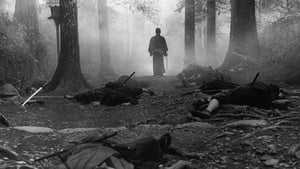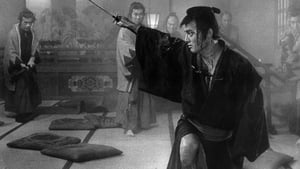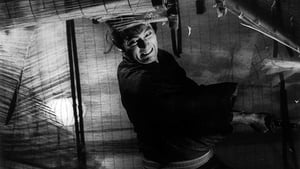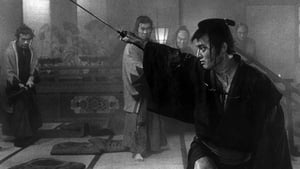Video Sources 0 Views
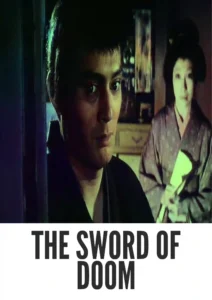
Synopsis

Immerse yourself in the brutal and mesmerizing world of The Sword of Doom, a 1966 Japanese jidaigeki film directed by Kihachi Okamoto, now powerfully colorized for a viewing experience that will leave you breathless. Starring the incomparable Tatsuya Nakadai as the amoral samurai Ryunosuke, this film is a chilling exploration of violence, madness, and the dark side of the soul. Perfect for fans of classic samurai films and those seeking a complex and unforgettable cinematic experience, this HD download brings a new dimension to a true masterpiece. Known in Japan as Dai-bosatsu Tōge (Great Bodhisattva Pass), this is not to be missed.
The Sword of Doom follows the grim path of Ryunosuke Tsukue (Tatsuya Nakadai), a master swordsman devoid of empathy and driven by an insatiable thirst for violence. From his initial act of killing an elderly pilgrim praying for death, Ryunosuke’s actions are marked by a chilling lack of remorse.
His descent continues as he coerces the wife of a fencing opponent into infidelity, leading to a duel where he kills the man with a single, decisive blow. Fleeing the town, he cuts down the man’s clansmen, leaving a trail of bloodshed in his wake. Two years later, Ryunosuke joins the Shinsengumi, a group of assassins who support the Tokugawa shogunate, further immersing himself in a world of murder and intrigue.
As Ryunosuke’s reputation grows, he attracts the attention of a skilled swordsman, Shimada Toranosuke (Toshiro Mifune), whose words about the soul of the sword begin to haunt him. His mistress, witnessing his unrelenting evil, attempts to kill him, leading to another act of violence. Haunted by the ghosts of his victims and the weight of his actions, Ryunosuke spirals into insanity. In a climactic and unforgettable scene, he confronts his demons in a burning brothel, engaging in a furious battle against countless assassins until he is finally overwhelmed, his sword raised in a final, desperate act of defiance as the film freezes.
The film features an extraordinary cast, each bringing depth and complexity to their roles:
-
Tatsuya Nakadai as Ryunosuke Tsukue
-
Yūzō Kayama as Hyoma Utsuki
-
Michiyo Aratama as Hama
-
Toshiro Mifune as Toranosuke Shimada
-
Yoko Naito as Omatsu
-
Kei Satō as Kamo Serizawa
The Sword of Doom transcends traditional genre classifications, blending elements of samurai action, psychological drama, and philosophical exploration. It is a powerful and unforgettable cinematic experience that delves into the darkest corners of the human soul.
Released in 1966, The Sword of Doom reflects the changing landscape of Japanese society and the anxieties of a nation grappling with modernization and social upheaval. The film’s portrayal of violence and moral ambiguity challenged traditional samurai ideals and offered a darker, more complex vision of the past. Its impact on samurai cinema is undeniable, influencing countless films that followed and solidifying its place as a true classic.
This colorized version of The Sword of Doom has been painstakingly restored using advanced digital technology, enhancing the visual impact of the film while remaining true to its original artistic vision. The colorization process involved a meticulous analysis of the black and white footage, with careful attention paid to recreating the colors and textures of the period. While the specific techniques used remain confidential, the results are nothing short of breathtaking, bringing a new level of depth and immersion to this timeless masterpiece.
-
: Kihachi Okamoto
-
: Shinobu Hashimoto
-
: Kaizan Nakazato
-
: Hiroshi Murai
-
: Yoshitami Kuroiwa
-
: Masaru Satô
-
: MP4
-
: HD (1080p)
-
: Compatible with most devices, including smartphones, tablets, computers, and smart TVs.
The Sword of Doom (1966) is widely regarded as a masterpiece of samurai cinema, praised for its stunning visuals, its complex characters, and its unflinching exploration of violence and morality. It remains a powerful and influential film, continuing to resonate with audiences around the world.
-
: What is The Sword of Doom about?
-
A: The Sword of Doom is a samurai film about an amoral swordsman who descends into madness.
-
-
: Is The Sword of Doom (1966) a well-known film?
-
A: Yes, The Sword of Doom is considered a classic of samurai cinema.
-
-
: Is this version of The Sword of Doom colorized?
-
A: Yes, this version has been professionally colorized to enhance the viewing experience.
-
-
: What makes The Sword of Doom interesting for classic film fans?
-
A: The Sword of Doom offers a unique and challenging exploration of violence, morality, and the human condition.
-
-
: What is the download format?
-
A: The download format is MP4, which is compatible with most devices.
-
-
: What resolution is the download?
-
A: The resolution is HD (1080p), providing a high-quality viewing experience.
-
Watch The Sword of Doom Today!
